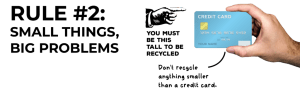Recycling can be tricky, and remembering which materials and objects are recyclable can be difficult. It’s time to start thinking about what we can do to recycle better and how to improve our recycling habits to help protect the environment.
Consistency across local authorities that have simpler streamlined guidelines is needed to ensure people continue and improve recycling at source.
-
1. No bags. Bring your own!
Plastics bags are incredibly harmful to the environment. These include sandwich bags, bubble wrap, plastic wrapping and other flimsy materials where the plastics are soft enough to push your finger through. Grocery bags dissolve into potentially harmful micro plastics and, in the case of ingestion or entanglement, hurt and kill animals.
Even though these bags are technically recyclable, you must go to a drop-off area to do that, not your general recycling bin.
This also means you shouldn’t bag your recyclables. Instead, dump them loosely right into your blue bins.
Solution: Buy a couple canvas bags, get some reusable containers.
-
2. Small things are big problems
You shouldn’t recycle anything smaller than a credit card. Items such as:
- Straws
- Bottle caps
- Coffee pods
- Plastic cutlery
- Paperclips

-
3. Make sure it’s clean, empty and dry
Food waste contaminates huge amounts of recyclable material, leaving them useless and results in them being sent to landfill.
Recyclable material needs to be clean. In some authority areas you can recycle pizza boxes, but not if they are covered in grease, but you can tear off the clean part and recycle it.
Solution: Make sure your recyclables are clean, empty and dry.

-
4. Combined materials may not be recyclable
Recycling works when similar materials are together. Which means that items such as plastic-coated coffee cups, laminated paper and paper bubble wrap envelopes from the mail can’t ever be separated, which means they’re NOT RECYCLABLE.
Solution: Try to avoid buying non-recyclable materials.
-
5. Know your plastics
Rigid plastics are recyclable, they are labelled by resin codes from 1-7. The higher the code the less recyclable it is. Plastics coded 1 and 2 are the easiest to be recycled and anything beyond that can be problematic.
Anything that can tear like paper should NOT BE RECYCLED, such as cracker bags, crisp bags or cereal bags as well as other things such as clamshell containers i.e. contaminated salad boxes, cutlery and plastic straws.
Solution: Try to avoid using these types of plastics by learning more about them. Visit Lets Recycle for more tips on recycling.
-
6. Stop ‘Wishcycling’
‘Wishcycling’ is when you optimistically put non-recyclable objects in the recycling bin. This results in recyclable products being contaminated and ending up in landfill. So by ‘wishcycling’ you potentially ruin the whole recycling system.
Solution: Don’t Wishcycle, if you’re unsure just use the rubbish bin or contact your local council.
-
7. Teach yourself
It’s hard to know everything about recycling, but if you take the first step and check if things can or can’t be recycled before disposing of them, then you’re on the right track. Visit www.letsrecycle.com for more tips on recycling.
Other items such as electronics, toys, clothing, batteries, paint cans and wood have different drop off points. It is best to visit your local recycling centre to dispose of these.
Visit our Applications to find your material and if it’s not there Get in Contact for your consultation.

